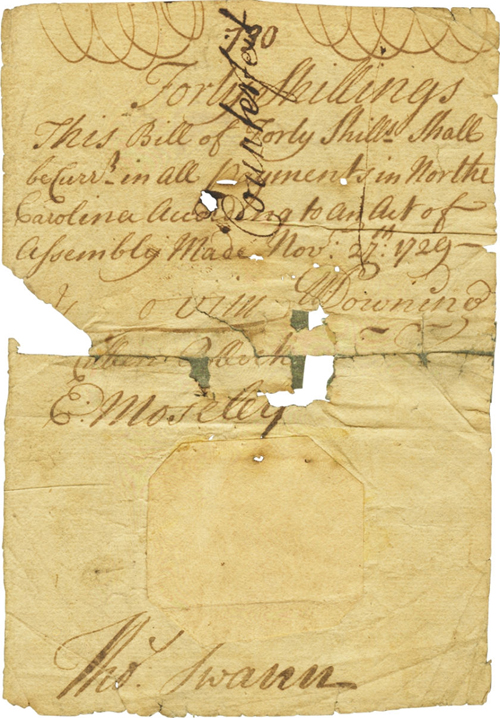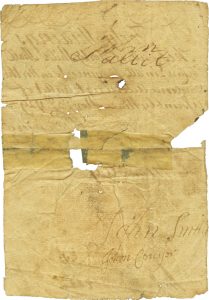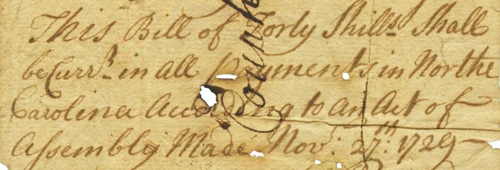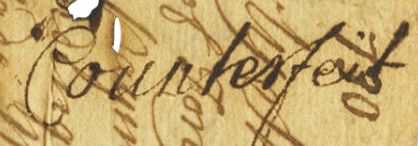In colonial North Carolina, paper money didn’t have the strong institutional backing it does today, and it was remarkably easy to counterfeit. Our July Artifact of the Month is a paper note from 1729 with a value of forty shillings… But was it real?

The preferred money of the time was coins of silver, gold, and copper. But Great Britain’s mercantilist colonial policy kept the flow of coins to the home country, and the colonies’ supply was always inadequate. To fill the need, all of Great Britain’s American colonies issued their own paper money. These notes were usually issued with little more than faith in the government as backing.
In 1690, Massachusetts became the first colony to issue its own paper money. North Carolina first issued paper money “bills of credit” in 1712 to finance a war against the Tuscarora Indians.
Unlike any other colony, North Carolina’s first four issues of paper money were produced without benefit of the printing press — they were all handwritten. The issues of 1712-13 and 1715 have no known surviving examples, but a few examples of the 1722 and 1729 issues are known. Our Artifact of the Month is an example of the last handwritten issue.
The note states “This Bill of Forty Shillings Shall be Current in North Carolina According to an Act of Assembly Made Nov 27, 1729.”
The note is serial number 730 and has a paper seal. It bears the signatures of John Lovick, William Downing, Cullen Pollock, Edward Moseley, and Thomas Swann. The back, originally blank, displays a couple of endorsements of bearers as the note circulated, a common practice with early North Carolina bills.

Handwritten paper money was highly susceptible to counterfeiting. The squiggly lines at top of this note were a simple means of counterfeit detection. If a note was brought to the proper governmental authority, it could be compared to the paper stubs with the top half of the squiggle with the same serial number.
Experts believe that most surviving examples of handwritten North Carolina paper money are counterfeits made by colonists (numismatists call these “contemporary counterfeits”). Some examples of these have been preserved in early court records of the prosecution of counterfeiters.
But what about our note? Is it a counterfeit? It was apparently condemned as counterfeit at the time, witnessed by the word “Counterfeit” penned at top.
One way to investigate would be to compare the signatures on the note with known-genuine signatures that are likely in the North Carolina State Archives. All five signers were prominent in local government and business, and it is likely that many of their documents have survived. As far as we know, no one has yet conducted this test, so we may attempt it ourselves.
Whether genuine or an early counterfeit, this is one of few survivors that attest to the severe money problems of early North Carolinians.
Those interested in learning more are referred to the excellent Money and Monetary Problems in Early North Carolina by Alan D. Watson, a 1980 publication of the North Carolina Department of Cultural Resources, Division of Archives and History.


